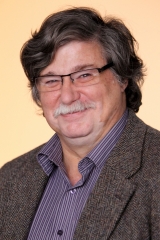
Dan V. Nicolau
Chair of the Department of Bioengineering
Endowed Professor of Engineering
Ph.D. Polytechnical University at Bucharest, Romania
M.S. Academy of Economic Studies at Bucharest, Romania
McGill, Macdonald Engineering Building, Room 375
Contact here
![]()
![]()
![]()
![]()
Introduction
I am the founding Chair of McGill’s Department of Bioengineering at the Faculty of Engineering. I have degrees in Chemical Engineering (PhD, MEng) and in Statistics, Cybernetics & Information Technology (MSc). My research covered polymer physico-chemistry, surface science and engineering, micro- and nanofabrication for semiconductor and biomedical devices, process modeling and control, protein adsorption, and recently biomimetics.
Before joining academia in 2000, I worked for more than 20 years in industry and industrial R&D environment, in Europe, Japan and Australia. Prior to moving to McGill, I was a professor at the University of Liverpool, UK; Monash and Swinburne Universities, Australia. I published more than 100 papers in peer-reviewed scientific journals, a similar number of full papers in conference proceedings and 6 book chapters. I edited a book on microarray technology, and co-edited the proceedings of 40 international conferences. I was the PI of research projects and research consortia, totaling more than $ 25 mil., granted by funding institutions in Europe, Japan, Australia, USA, UK, Brazil and Canada. I am an Editor of Biosensors & Bioelectronics, an Editor of Scientific Reports, a Fellow of the International Society of Optical Engineering (SPIE).
My research interests are currently focusing on three themes:
- Biomimetics, from nano- or micro-structured surfaces mimicking Nature’s technical solutions that efficiently control the wetting, to intelligent-like algorithms used by microorganisms for space and nutrient searching, essential for survival and growth;
- Micro- and nano-fluidics devices, from lab-on-a-chip devices, to dynamic nano-devices based on protein molecular motors, for drug discovery, diagnostics and biocomputation;
- Fundamentals of the interactions of proteins and DNA with surfaces, which are either flat or micro/nano-structured, fabricated via classical microlithography, or via micro-ablation, for applications in biomedical microdevices and biomaterials.
My key contributions and technological accomplishments comprise
chronological order, selected publications):
- Patterning beyond optical resolution in photosensitive polymers (1989-2010)
Fulga, F. and D.V. Nicolau, Consequences of non-standard bleaching on microlithographic performance. Microelectronic Engineering, 2009. 86(4-6): p. 783-786 MoreLess
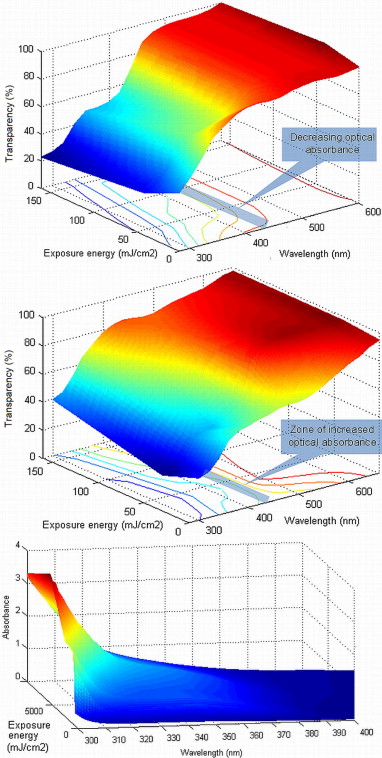 Photobleaching of photoresists has been at the core of high resolution relative to a particular exposure wavelength, but the accelerated advancements dictated by the sharp economic considerations of the roadmap, as well as the complexity of exposure-material-technology triad, made photobleaching a secondary subject of interest. However, the still-strong innovation in optical photolithography as well as the emergence of biomedical microdevices as a major market for microfabrication, suggest that the reconsideration of the photobleaching as a main modulator of lithographic performance is fully warranted. This study reports on the photolithography simulations which implemented a non-standard bleaching behaviour, both documented previously and hypothetical. We show that minute changes in the photobleaching behaviour can result in important changes in the performance of the lithographic process latitude, speed and resist profile.
Photobleaching of photoresists has been at the core of high resolution relative to a particular exposure wavelength, but the accelerated advancements dictated by the sharp economic considerations of the roadmap, as well as the complexity of exposure-material-technology triad, made photobleaching a secondary subject of interest. However, the still-strong innovation in optical photolithography as well as the emergence of biomedical microdevices as a major market for microfabrication, suggest that the reconsideration of the photobleaching as a main modulator of lithographic performance is fully warranted. This study reports on the photolithography simulations which implemented a non-standard bleaching behaviour, both documented previously and hypothetical. We show that minute changes in the photobleaching behaviour can result in important changes in the performance of the lithographic process latitude, speed and resist profile.
- Patterning of biomolecules and cells on micro- and nano-structures (1996-present)
Separation-free detection of biological molecules based on plasmon-enhanced fluorescence. Angewandte Chemie - International Edition, 2011. 50(9): p. 2151-2154 MoreLess
Optical antenna: The fluorescence of analyte molecules in proximity to noble-metal nanostructures is enhanced by plasmon-induced electric fields (see schematic). This phenomenon allows the progress of molecular binding events of biological molecules to be monitored in real-time.
- New types of diagnostic devices using protein molecular motors (1999-present)
Nicolau, D.V., et al., Actin motion on microlithographically functionalized myosin surfaces and tracks. Biophysical Journal, 1999. 77(2): p. 1126-1134 MoreLess
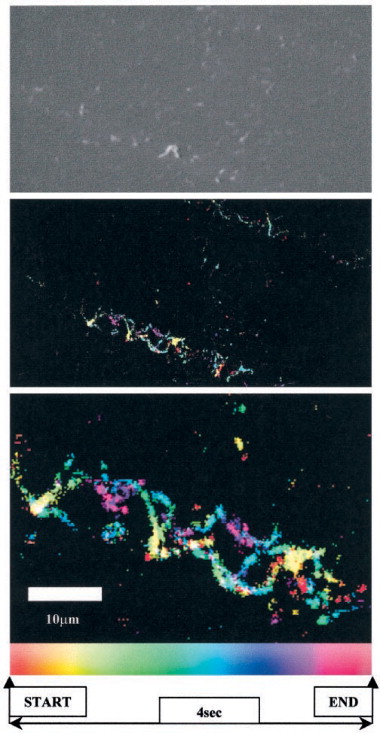 High-resolution e-beam patterning exposure of the surface of poly[(tert-butyl-methacrylate)-co-(methyl methacrylate)]—a common e-beam and deep-UV resist used in semiconductor microlithography—induced sharp changes in the surface hydrophobicity. These differences in hydrophobicity resulted in the selective attachment of heavy meromyosin to hydrophobic, unexposed surfaces. The movement of the actin filaments on myosin-rich and myosin-poor surfaces was statistically characterized in terms of velocity, acceleration, and angle of movement. The actin filaments have a smooth motion on myosin-rich surfaces and an uneven motion on myosin-poor surfaces. Interestingly, an excess of myosin sites has a slowing, albeit mild effect on the motion of the actin filaments. It was also found that the myosin-rich/myosin-poor boundary has an alignment-enforcement effect, especially for the filaments approaching the border from the myosin-rich side. Based on these results, we discuss the feasibility of building purposefully designed molecular motor arrays and the testing of the hypotheses regarding the functioning of the molecular motors.
High-resolution e-beam patterning exposure of the surface of poly[(tert-butyl-methacrylate)-co-(methyl methacrylate)]—a common e-beam and deep-UV resist used in semiconductor microlithography—induced sharp changes in the surface hydrophobicity. These differences in hydrophobicity resulted in the selective attachment of heavy meromyosin to hydrophobic, unexposed surfaces. The movement of the actin filaments on myosin-rich and myosin-poor surfaces was statistically characterized in terms of velocity, acceleration, and angle of movement. The actin filaments have a smooth motion on myosin-rich surfaces and an uneven motion on myosin-poor surfaces. Interestingly, an excess of myosin sites has a slowing, albeit mild effect on the motion of the actin filaments. It was also found that the myosin-rich/myosin-poor boundary has an alignment-enforcement effect, especially for the filaments approaching the border from the myosin-rich side. Based on these results, we discuss the feasibility of building purposefully designed molecular motor arrays and the testing of the hypotheses regarding the functioning of the molecular motors.
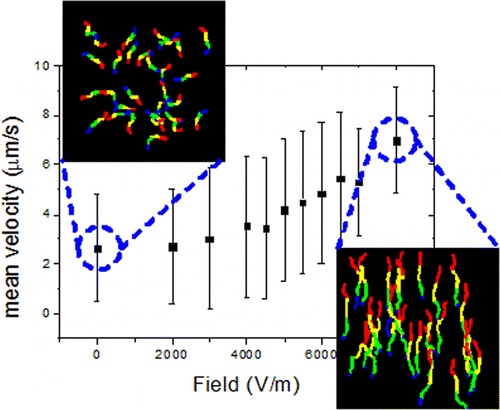 The efficiency of dynamic nanodevices using surface-immobilized protein molecular motors, which have been proposed for diagnostics, drug discovery, and biocomputation, critically depends on the ability to precisely control the motion of motor-propelled, individual cytoskeletal filaments transporting cargo to designated locations. The efficiency of these devices also critically depends on the proper function of the propelling motors, which is controlled by their interaction with the surfaces they are immobilized on. Here we use a microfluidic device to study how the motion of the motile elements, i.e., actin filaments propelled by heavy mero-myosin (HMM) motor fragments immobilized on various surfaces, is altered by the application of electrical loads generated by an external electric field with strengths ranging from 0 to 8 kVm–1. Because the motility is intimately linked to the function of surface-immobilized motors, the study also showed how the adsorption properties of HMM on various surfaces, such as nitrocellulose (NC), trimethylclorosilane (TMCS), poly(methyl methacrylate) (PMMA), poly(tert-butyl methacrylate) (PtBMA), and poly(butyl methacrylate) (PBMA), can be characterized using an external field. It was found that at an electric field of 5 kVm–1 the force exerted on the filaments is sufficient to overcome the frictionlike resistive force of the inactive motors. It was also found that the effect of assisting electric fields on the relative increase in the sliding velocity was markedly higher for the TMCS-derivatized surface than for all other polymer-based surfaces. An explanation of this behavior, based on the molecular rigidity of the TMCS-on-glass surfaces as opposed to the flexibility of the polymer-based ones, is considered. To this end, the proposed microfluidic device could be used to select appropriate surfaces for future lab-on-a-chip applications as illustrated here for the almost ideal TMCS surface. Furthermore, the proposed methodology can be used to gain fundamental insights into the functioning of protein molecular motors, such as the force exerted by the motors under different operational conditions.
The efficiency of dynamic nanodevices using surface-immobilized protein molecular motors, which have been proposed for diagnostics, drug discovery, and biocomputation, critically depends on the ability to precisely control the motion of motor-propelled, individual cytoskeletal filaments transporting cargo to designated locations. The efficiency of these devices also critically depends on the proper function of the propelling motors, which is controlled by their interaction with the surfaces they are immobilized on. Here we use a microfluidic device to study how the motion of the motile elements, i.e., actin filaments propelled by heavy mero-myosin (HMM) motor fragments immobilized on various surfaces, is altered by the application of electrical loads generated by an external electric field with strengths ranging from 0 to 8 kVm–1. Because the motility is intimately linked to the function of surface-immobilized motors, the study also showed how the adsorption properties of HMM on various surfaces, such as nitrocellulose (NC), trimethylclorosilane (TMCS), poly(methyl methacrylate) (PMMA), poly(tert-butyl methacrylate) (PtBMA), and poly(butyl methacrylate) (PBMA), can be characterized using an external field. It was found that at an electric field of 5 kVm–1 the force exerted on the filaments is sufficient to overcome the frictionlike resistive force of the inactive motors. It was also found that the effect of assisting electric fields on the relative increase in the sliding velocity was markedly higher for the TMCS-derivatized surface than for all other polymer-based surfaces. An explanation of this behavior, based on the molecular rigidity of the TMCS-on-glass surfaces as opposed to the flexibility of the polymer-based ones, is considered. To this end, the proposed microfluidic device could be used to select appropriate surfaces for future lab-on-a-chip applications as illustrated here for the almost ideal TMCS surface. Furthermore, the proposed methodology can be used to gain fundamental insights into the functioning of protein molecular motors, such as the force exerted by the motors under different operational conditions.
- Atomic Force Microscopy-based analysis of molecular orientation of ssDNA on surfaces and the quantification of the level of hybridization (2002-present)
Nicolau, D.V., Pham, D.K., Ivanova, E.P., Wright, J.P., Lenigk, R., Smekal, T., Grodzinski, P., 2005. Tone reversal of an AFM lateral force image due to hybridization of oligonucleotides immobilized on polymers. Small 1, 610-613 MoreLess
 The interaction between oligonucleotide strands and polymer chains on surfaces has been investigated by AFM and XPS, with cyclo-olefin-copolymer (COC) and polycarbonate (PC) as model polymers (see image). Lower friction recorded by the AFM tip when mapping the aggregates of covalently bound amino-terminated ssDNA chains on COC and PC surfaces can be explained by the preferential orientation of the free hydrophobic bases towards the outside of the aggregates; hybridization of the ssDNA aggregates leads to tone reversal of the lateral force image.
The interaction between oligonucleotide strands and polymer chains on surfaces has been investigated by AFM and XPS, with cyclo-olefin-copolymer (COC) and polycarbonate (PC) as model polymers (see image). Lower friction recorded by the AFM tip when mapping the aggregates of covalently bound amino-terminated ssDNA chains on COC and PC surfaces can be explained by the preferential orientation of the free hydrophobic bases towards the outside of the aggregates; hybridization of the ssDNA aggregates leads to tone reversal of the lateral force image.
- The demonstration of the optimality of search algorithms used by microorganisms for space exploration (2003-present)
Hanson, K.L., et al., Fungi use efficient algorithms for the exploration of microfluidic networks. Small, 2006. 2(10): p. 1212-1220 MoreLess
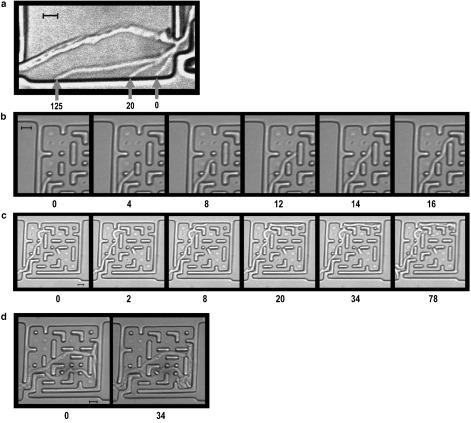 Fungi, in particular, basidiomycetous fungi, are very successful in colonizing microconfined mazelike networks (for example, soil, wood, leaf litter, plant and animal tissues), a fact suggesting that they may be efficient solving agents of geometrical problems. We therefore evaluated the growth behavior and optimality of fungal space-searching algorithms in microfluidic mazes and networks. First, we found that fungal growth behavior was indeed strongly modulated by the geometry of microconfinement. Second, the fungus used a complex growth and space-searching strategy comprising two algorithmic subsets: 1) long-range directional memory of individual hyphae and 2) inducement of branching by physical obstruction. Third, stochastic simulations using experimentally measured parameters showed that this strategy maximizes both survival and biomass homogeneity in microconfined networks and produces optimal results only when both algorithms are synergistically used. This study suggests that even simple microorganisms have developed adequate strategies to solve nontrivial geometrical problems.
Fungi, in particular, basidiomycetous fungi, are very successful in colonizing microconfined mazelike networks (for example, soil, wood, leaf litter, plant and animal tissues), a fact suggesting that they may be efficient solving agents of geometrical problems. We therefore evaluated the growth behavior and optimality of fungal space-searching algorithms in microfluidic mazes and networks. First, we found that fungal growth behavior was indeed strongly modulated by the geometry of microconfinement. Second, the fungus used a complex growth and space-searching strategy comprising two algorithmic subsets: 1) long-range directional memory of individual hyphae and 2) inducement of branching by physical obstruction. Third, stochastic simulations using experimentally measured parameters showed that this strategy maximizes both survival and biomass homogeneity in microconfined networks and produces optimal results only when both algorithms are synergistically used. This study suggests that even simple microorganisms have developed adequate strategies to solve nontrivial geometrical problems.
Courses
- BIEN 520: High Throughput Bioanalytical Devices (3 credits) MoreLess
Introduction to the field of high throughput screening (HTS) analytical techniques and devices used for genomics, proteomics and other “omics” approaches, as well as for diagnostics, or for more special cases, e.g., screening for biomaterials. Introduction into the motivation of HTS and its fundamental physico-chemical challenges; techniques used to design, fabricate and operate HTS devices, such as microarrays and new generation DNA screening based on nanotechnology. Specific applications: DNA, protein and diagnostic and cell and tissue arrays.
*Open to students in Anatomy and Cell Biology, Biochemistry, Biomedical Engineering, Bioresource Engineering, Chemical Engineering, Human Genetics, Mechanical Engineering, and Quantitative Biology.
Publications

